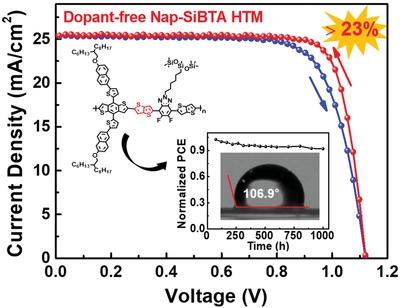当前位置:
X-MOL 学术
›
Adv. Energy Mater.
›
论文详情
Our official English website, www.x-mol.net, welcomes your
feedback! (Note: you will need to create a separate account there.)
Thienothiophene-Assisted Property Optimization for Dopant-Free π-Conjugation Polymeric Hole Transport Material Achieving Over 23% Efficiency in Perovskite Solar Cells
Advanced Energy Materials ( IF 24.4 ) Pub Date : 2022-11-26 , DOI: 10.1002/aenm.202202680 Zhiqing Xie 1, 2 , Hyungjin Park 1 , SeungJu Choi 3 , Ho‐Yeol Park 1 , Thavamani Gokulnath 1 , Hyerin Kim 1 , Jeonghyun Kim 1 , Hak‐Beom Kim 3 , In Woo Choi 3 , Yimhyun Jo 3 , Dong Suk Kim 3 , Young‐Yong Kim 4 , Seog Young Yoon 2 , Jinhwan Yoon 1 , Yong‐Rae Cho 2 , Sung‐Ho Jin 1
Advanced Energy Materials ( IF 24.4 ) Pub Date : 2022-11-26 , DOI: 10.1002/aenm.202202680 Zhiqing Xie 1, 2 , Hyungjin Park 1 , SeungJu Choi 3 , Ho‐Yeol Park 1 , Thavamani Gokulnath 1 , Hyerin Kim 1 , Jeonghyun Kim 1 , Hak‐Beom Kim 3 , In Woo Choi 3 , Yimhyun Jo 3 , Dong Suk Kim 3 , Young‐Yong Kim 4 , Seog Young Yoon 2 , Jinhwan Yoon 1 , Yong‐Rae Cho 2 , Sung‐Ho Jin 1
Affiliation

|
Hole transport materials (HTMs) play essential roles in achieving high photovoltaic performance and long-term stability in the n–i–p structure of perovskite solar cell (PSC) devices. Recently, dopant-free polymeric materials as HTMs in PSCs have attracted considerable attention owing to high carrier mobility and excellent hydrophobicity. However, achieving similar efficiencies to those of doped small molecule HTMs such as Spiro-OMeTAD is a big challenge. Herein, a thienothiophene π-bridge is selected as a stabilizer and energy level regulator incorporated into a donor–acceptor-type HTM to synthesize a new polymer, Nap-SiBTA. The incorporation of the thienothiophene group improves the thermal stability and favors the high planarity and face-on orientation, promoting high charge carrier mobility and tunable optical band gap. Finally, the dopant-free polymer Nap-SiBTA-based PSC achieves an excellent power conversion efficiency (PCE) of 23.07% with a high fill factor of 80.85%. To the best of the authors’ knowledge, this is one of the best efficiencies in dopant-free HTM PSCs. Moreover, the unencapsulated device retains 93% of its initial PCE after 1000 h owing to the excellent hydrophobicity of Nap-SiBTA. This work provides a general and practical method to design dopant-free HTMs for the high efficiency and long-term stability of PSCs.
中文翻译:

无掺杂 π 共轭聚合物空穴传输材料的噻吩并噻吩辅助性能优化在钙钛矿太阳能电池中实现超过 23% 的效率
空穴传输材料 (HTM) 在钙钛矿太阳能电池 (PSC) 器件的 n-i-p 结构中实现高光伏性能和长期稳定性方面发挥着重要作用。最近,由于高载流子迁移率和优异的疏水性,作为 PSC 中的 HTM 的无掺杂聚合物材料引起了相当大的关注。然而,实现与 Spiro-OMeTAD 等掺杂小分子 HTM 相似的效率是一个巨大的挑战。在此,选择噻吩并噻吩 π 桥作为稳定剂和能级调节剂并入供体-受体型 HTM 以合成新型聚合物 Nap-SiBTA。噻吩并噻吩基团的加入提高了热稳定性,有利于高平面性和正面取向,促进高电荷载流子迁移率和可调光学带隙。最后,基于无掺杂聚合物 Nap-SiBTA 的 PSC 实现了 23.07% 的出色功率转换效率 (PCE) 和 80.85% 的高填充因子。据作者所知,这是无掺杂 HTM PSC 中效率最高的一种。此外,由于 Nap-SiBTA 出色的疏水性,未封装的装置在 1000 小时后保留了其初始 PCE 的 93%。这项工作为设计无掺杂 HTM 以实现 PSC 的高效率和长期稳定性提供了一种通用且实用的方法。由于 Nap-SiBTA 出色的疏水性,未封装的装置在 1000 小时后保留了其初始 PCE 的 93%。这项工作为设计无掺杂 HTM 以实现 PSC 的高效率和长期稳定性提供了一种通用且实用的方法。由于 Nap-SiBTA 出色的疏水性,未封装的装置在 1000 小时后保留了其初始 PCE 的 93%。这项工作为设计无掺杂 HTM 以实现 PSC 的高效率和长期稳定性提供了一种通用且实用的方法。
更新日期:2022-11-26
中文翻译:

无掺杂 π 共轭聚合物空穴传输材料的噻吩并噻吩辅助性能优化在钙钛矿太阳能电池中实现超过 23% 的效率
空穴传输材料 (HTM) 在钙钛矿太阳能电池 (PSC) 器件的 n-i-p 结构中实现高光伏性能和长期稳定性方面发挥着重要作用。最近,由于高载流子迁移率和优异的疏水性,作为 PSC 中的 HTM 的无掺杂聚合物材料引起了相当大的关注。然而,实现与 Spiro-OMeTAD 等掺杂小分子 HTM 相似的效率是一个巨大的挑战。在此,选择噻吩并噻吩 π 桥作为稳定剂和能级调节剂并入供体-受体型 HTM 以合成新型聚合物 Nap-SiBTA。噻吩并噻吩基团的加入提高了热稳定性,有利于高平面性和正面取向,促进高电荷载流子迁移率和可调光学带隙。最后,基于无掺杂聚合物 Nap-SiBTA 的 PSC 实现了 23.07% 的出色功率转换效率 (PCE) 和 80.85% 的高填充因子。据作者所知,这是无掺杂 HTM PSC 中效率最高的一种。此外,由于 Nap-SiBTA 出色的疏水性,未封装的装置在 1000 小时后保留了其初始 PCE 的 93%。这项工作为设计无掺杂 HTM 以实现 PSC 的高效率和长期稳定性提供了一种通用且实用的方法。由于 Nap-SiBTA 出色的疏水性,未封装的装置在 1000 小时后保留了其初始 PCE 的 93%。这项工作为设计无掺杂 HTM 以实现 PSC 的高效率和长期稳定性提供了一种通用且实用的方法。由于 Nap-SiBTA 出色的疏水性,未封装的装置在 1000 小时后保留了其初始 PCE 的 93%。这项工作为设计无掺杂 HTM 以实现 PSC 的高效率和长期稳定性提供了一种通用且实用的方法。











































 京公网安备 11010802027423号
京公网安备 11010802027423号